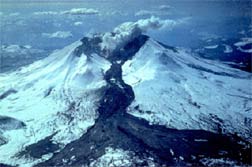
|
|
Landslides:
Exploring Energy Transfer and Landslides
|
Focus Question: What are landslides?
A mass-movement process in which rock or sediment moves downslope.
Focus Question: Where do we most often see landslides?
In areas with:
Focus Question: What conditions cause the downslope movement?
-
excessive rainfall, snowmelt
-
oversteepened slopes that exceed the angle of repose, typically ~
30°
-
earthquakes and volcanic activity
-
the nature and level of saturation of the substrate
-
sinkholes
Focus Question: Where do landslides occur?
In many settings on Earth:
|
|
Rockfall deposition - Yosemite National Park, California
- On July 11, 1996, at 6:52 p.m. (Pacific Daylight Time), two large
rock blocks, with a combined volume of between 23,000 and 38,000
m3 broke away from Glacier Point, near Happy Isles, a popular trailhead
and concession stand.
Photograph by Edwin Harp, U.S. Geological Survey.
|
|
|
|

|
Debris Flow - La Conchita, California - a small seaside
community along Highway 101 north of Santa Barbara. This landslide
and debris flow occurred in the spring of 1995. Many people were
evacuated because of the slide and the houses nearest the slide
were completely destroyed. Fortunately, no one was killed or injured.
Photograph by R.L. Schuster, U.S. Geological Survey.
|
|
|
Snow-induced landslide - Melting snow and ice on
the north flank of Washington's Mount St. Helens, triggered this
lahar (an Indonesian term for a "volcanic debris flow"), which rapidly
traveled down the flanks of the mountain with the North Fork of
the Toutle River. The melting snow and Ice resulted from the 1982
eruption of Mount St. Helens.
Photograph by Tom Casadevall, U.S. Geological Survey.
|
|
|
|

|
Earthquake-induced rock and snow avalanche – deposits
path of the Mt. Huascaran, Peru, rock and snow avalanche.
Photo courtesy of Servicio Aerofotografico Nacional de Peru, 13
June 1970, U.S. Geological Survey.
|
|
|
Sinkhole - Winter Park, Florida-Sinkholes, although
not classified as landslides, are another form of ground subsidence
that can happen catastrophically. This sinkhole occurred in 1981,
in the time span of one day. This form of subsidence occurs when
carbonate layers that lie below the surface dissolve. When the weight
of the overlying ground becomes too great, or the dissolved area
too large, the surface collapses into the void.
Photograph by A. S. Navoy, U.S. Geological Survey.
|
|
|
Additional Resources:
For more pictures and information on landslides, visit Geologic
Hazards – Landslides at the United States Geological Survey website.
|
Return to: Potential to Kinetic | Dynamic
Earth Homepage | UCMP Homepege
|
|




